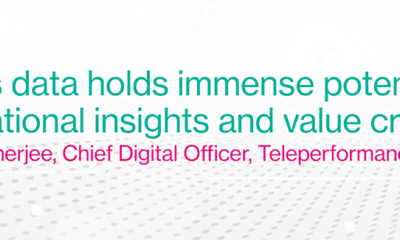Politics
How LoRaWAN and Massive IoT are Reshaping Business and Society
Published
8 months agoon
By
Drew Simpson
Over the past several years, the Internet of Things (IoT) has reached new heights. We now find ourselves on the cusp of the “Massive IoT” era, where the technology is reaching a nearly unimaginable scale due to the number of sensors and devices entering the market. Along with that comes new possibilities to operate businesses and address global challenges that were not feasible even five years ago.
Valuable use cases are already forming across industries, creating new ways to monitor resources, optimize processes, and save costs. Sensor devices deliver data about an asset’s location, condition, and other time-sensitive operational statuses that help prevent costly losses or potential liabilities. However, in order for the IoT to function correctly as it continues to grow, its ability to scale hinges on the expansion of Low Power Wide Area Networks (LPWANs) designed to support large-scale deployments of sensors that work seamlessly for decades at a time. Additionally, these networks need to be able to support different public and private deployment models, simplify the management of networking tasks, and scale on demand as needs and priorities change.
LoRaWAN has surged ahead of competing LPWAN solutions in meeting those needs due to its unique combination of cost efficiency, low power consumption, long-range, and non-proprietary model. Because of its functionality, according to the LoRa Alliance, it now leads global, at-scale LPWAN deployments across all metrics, ranging from the most solutions available, devices deployed, messages sent, and network availability, with coverage offered in more than 76,000 cities in 188 countries.
The value provided by large-scale IoT sensor deployments far outweighs the costs of moving away from legacy technologies and manual processes, which require relying on networks that are ill-fit to the requirements of the devices they support and lack the flexibility to adapt. To that end, the following three examples illustrate how IoT connectivity using LPWAN networks like LoRaWAN is improving public safety, conserving resources, and providing other unprecedented benefits by enabling businesses to do far more than they ever could.
Smart buildings and campuses – improving air quality
Smog, wildfires and other sources of pollution create unhealthy air that impacts health. Recent research by the American Lung Association found that 40% of the country lives in areas with failing grades of particle pollution or ozone. But poor air quality can extend to inside buildings and campuses too. For example, the pandemic taught us the importance of proper ventilation and good indoor air quality. Sensor monitoring can help in both environments, not only giving states and municipalities an easy way to monitor environmental safety conditions like wildfire smoke or other air pollution, but enabling building owners to monitor indoor air quality.
Indoor air quality (IAQ) monitoring aims to measure and reduce pollutants indoors for the health and comfort of a building’s occupants, to ensure proper ventilation, air processing and filtration. Using sensors to monitor IAQ in smart building and campus environments helps to identify and reduce air pollution, viruses, and contamination that cause occupants discomfort and respiratory issues.
When deployed, IoT sensors provide building managers temperature, humidity, and CO2 level data. In the event a potential danger is detected, managers can execute remote commands and alarms to alert anyone in the building. The sensors also help to gather data to optimize heat or air conditioning usage, giving building owners the added benefit of saving energy costs.
To effectively monitor air quality, IoT devices require network connectivity to share data. To do that, their signals need to be able to pass through building materials without being blocked, never lose power, and periodically send small data packets. LoRaWaN supports this functionality and communication. Once building owners and operators have the data, they can further analyze it to identify where ventilation needs to be improved or where liabilities exist.
Natural Gas – preventing dangerous leaks
Like CO2 and poor air quality, methane and natural gas leaks are common and potentially an even more dangerous hazard. Outside of building environments, leaks can occur in pipelines and other related infrastructure. Methane leaks in urban areas have been reported to be more than two times higher than EPA estimates, which is why many gas utilities are implementing sensing and alerting systems with valve shut-off capabilities to provide more visibility and improve public safety wherever possible.
With sensors spread throughout all their infrastructure, gas utilities can gain complete awareness and control of their gas distribution systems, including automating the secure shutdown of single or multiple valves. In the past, natural gas utilities were unaware of leaks until long after they occurred, at which point most damage was already done.
These automated systems that detect hazards and shut off the flow of gas improve safety and reduce the risk of life-threatening incidents for residential and commercial building owners. Their connectivity needs to always work and communicate across long distances due to the spread-out nature of infrastructure. Additionally, using LoRaWAN to connect these sensors opens the possibility of obtaining additional property management sensor data to prevent things like water leaks, rodents, HVAC malfunctions, and more.
Water Utilities – conserving a resource that is becoming scarce
As we have seen in recent years, droughts are becoming far more common. Municipalities, water utilities, and residents must work together to conserve and distribute water.
Smart water metering in residential and commercial properties allows water utilities to measure trends in water usage wherever it is delivered without manual intervention. IHS Markit forecasts that almost 50 million smart water meters will ship globally in 2023, roughly four times more than in 2017.
Advanced Metering Infrastructure (AMI) is not limited to Automatic Meter Reading (AMR), which allows utilities to bill customers directly based on their usage data. The data collected can also help reduce water loss through improved leak detection, streamline billing through enhanced water flow monitoring, and implement new rate structures to incentivize water conservation among customers. Additionally, the two-way communication between utilities and their metering devices can improve infrastructure diagnostics, provide advanced data analytics, and enhance field operations – all while giving tenants more detailed information about water consumption.
Perhaps most beneficial for water utilities, the wireless communication networks deployed by modern AMI systems are ideal for supporting multiple water metering and management applications. Establishing a shared LoRaWAN network infrastructure allows municipalities to support a wide range of commercial and citizen-facing applications beyond just water AMI.
Why LoRaWAN
For large-scale IoT deployments with relatively low data payloads that seldom require low latency — such as water metering and infrastructure monitoring – LoRaWAN has proven to be a cost-effective new technology investment and long-term replacement option for legacy systems. For critical infrastructure and essential enterprise IoT projects, LoRaWAN remains the leading choice given its open standards, propagation characteristics, extended end-device battery life, ease of deployment, and low cost.
Since its inception, LoRaWAN has been designed to connect low-cost, battery-operated sensors over long distances wirelessly. Once established, a LoRaWAN network is designed to support the broader set of resource conservation and sustainability initiatives prioritized at municipal levels across the country and worldwide today. Additionally, LoRaWAN’s open standards mean that end users can deploy ever-growing LoRaWAN-enabled devices on the network, offering more flexibility in deployment and more devices that function with the network compared to proprietary connectivity solutions.
As businesses and municipalities consider how data can be used to optimize their operations and services, they must also consider the networks on which IoT devices and their data depend. With LoRaWAN, organizations across industries can realize the cost, safety and resource conservation benefits of the Internet of Things.
Featured Image Credit:
Bruce Chatterley
Bruce Chatterley is President and CEO of Senet, a developer of cloud-based network management and operating systems for Internet of Things (IoT) connectivity. Over a 30 year career, Mr. Chatterley has served as the leader of multiple high growth businesses in Data Center Security and Managed Services (Layeredtech), Telecommunications (Speakeasy/Ameritech/US West), and Software-as-a-Service (Concur, ViAir). Earlier in his career Chatterley held Senior Sales, Marketing, and Product positions at GE and IBM.
Bruce Chatterley holds a BSBA from Central Michigan University and an MBA from the Kogod College of Business Administration at American University in Washington DC.
You may like
-


What are the hardest problems in tech we should be more focused on as a society?
-


Using Augmented Reality to Level up your E-Commerce Business
-


Data analytics reveal real business value
-


How does ERP Helps to improve Business Operations?
-


Lateral Movement: What Every Business Should Know
-


Unleashing Smart Contracts for Business Breakthroughs
Politics
Fintech Kennek raises $12.5M seed round to digitize lending
Published
7 months agoon
10/11/2023By
Drew Simpson
London-based fintech startup Kennek has raised $12.5 million in seed funding to expand its lending operating system.
According to an Oct. 10 tech.eu report, the round was led by HV Capital and included participation from Dutch Founders Fund, AlbionVC, FFVC, Plug & Play Ventures, and Syndicate One. Kennek offers software-as-a-service tools to help non-bank lenders streamline their operations using open banking, open finance, and payments.
The platform aims to automate time-consuming manual tasks and consolidate fragmented data to simplify lending. Xavier De Pauw, founder of Kennek said:
“Until kennek, lenders had to devote countless hours to menial operational tasks and deal with jumbled and hard-coded data – which makes every other part of lending a headache. As former lenders ourselves, we lived and breathed these frustrations, and built kennek to make them a thing of the past.”
The company said the latest funding round was oversubscribed and closed quickly despite the challenging fundraising environment. The new capital will be used to expand Kennek’s engineering team and strengthen its market position in the UK while exploring expansion into other European markets. Barbod Namini, Partner at lead investor HV Capital, commented on the investment:
“Kennek has developed an ambitious and genuinely unique proposition which we think can be the foundation of the entire alternative lending space. […] It is a complicated market and a solution that brings together all information and stakeholders onto a single platform is highly compelling for both lenders & the ecosystem as a whole.”
The fintech lending space has grown rapidly in recent years, but many lenders still rely on legacy systems and manual processes that limit efficiency and scalability. Kennek aims to leverage open banking and data integration to provide lenders with a more streamlined, automated lending experience.
The seed funding will allow the London-based startup to continue developing its platform and expanding its team to meet demand from non-bank lenders looking to digitize operations. Kennek’s focus on the UK and Europe also comes amid rising adoption of open banking and open finance in the regions.
Featured Image Credit: Photo from Kennek.io; Thank you!
Radek Zielinski
Radek Zielinski is an experienced technology and financial journalist with a passion for cybersecurity and futurology.
Politics
Fortune 500’s race for generative AI breakthroughs
Published
7 months agoon
10/11/2023By
Drew Simpson
As excitement around generative AI grows, Fortune 500 companies, including Goldman Sachs, are carefully examining the possible applications of this technology. A recent survey of U.S. executives indicated that 60% believe generative AI will substantially impact their businesses in the long term. However, they anticipate a one to two-year timeframe before implementing their initial solutions. This optimism stems from the potential of generative AI to revolutionize various aspects of businesses, from enhancing customer experiences to optimizing internal processes. In the short term, companies will likely focus on pilot projects and experimentation, gradually integrating generative AI into their operations as they witness its positive influence on efficiency and profitability.
Goldman Sachs’ Cautious Approach to Implementing Generative AI
In a recent interview, Goldman Sachs CIO Marco Argenti revealed that the firm has not yet implemented any generative AI use cases. Instead, the company focuses on experimentation and setting high standards before adopting the technology. Argenti recognized the desire for outcomes in areas like developer and operational efficiency but emphasized ensuring precision before putting experimental AI use cases into production.
According to Argenti, striking the right balance between driving innovation and maintaining accuracy is crucial for successfully integrating generative AI within the firm. Goldman Sachs intends to continue exploring this emerging technology’s potential benefits and applications while diligently assessing risks to ensure it meets the company’s stringent quality standards.
One possible application for Goldman Sachs is in software development, where the company has observed a 20-40% productivity increase during its trials. The goal is for 1,000 developers to utilize generative AI tools by year’s end. However, Argenti emphasized that a well-defined expectation of return on investment is necessary before fully integrating generative AI into production.
To achieve this, the company plans to implement a systematic and strategic approach to adopting generative AI, ensuring that it complements and enhances the skills of its developers. Additionally, Goldman Sachs intends to evaluate the long-term impact of generative AI on their software development processes and the overall quality of the applications being developed.
Goldman Sachs’ approach to AI implementation goes beyond merely executing models. The firm has created a platform encompassing technical, legal, and compliance assessments to filter out improper content and keep track of all interactions. This comprehensive system ensures seamless integration of artificial intelligence in operations while adhering to regulatory standards and maintaining client confidentiality. Moreover, the platform continuously improves and adapts its algorithms, allowing Goldman Sachs to stay at the forefront of technology and offer its clients the most efficient and secure services.
Featured Image Credit: Photo by Google DeepMind; Pexels; Thank you!
Deanna Ritchie
Managing Editor at ReadWrite
Deanna is the Managing Editor at ReadWrite. Previously she worked as the Editor in Chief for Startup Grind and has over 20+ years of experience in content management and content development.
Politics
UK seizes web3 opportunity simplifying crypto regulations
Published
7 months agoon
10/10/2023By
Drew Simpson
As Web3 companies increasingly consider leaving the United States due to regulatory ambiguity, the United Kingdom must simplify its cryptocurrency regulations to attract these businesses. The conservative think tank Policy Exchange recently released a report detailing ten suggestions for improving Web3 regulation in the country. Among the recommendations are reducing liability for token holders in decentralized autonomous organizations (DAOs) and encouraging the Financial Conduct Authority (FCA) to adopt alternative Know Your Customer (KYC) methodologies, such as digital identities and blockchain analytics tools. These suggestions aim to position the UK as a hub for Web3 innovation and attract blockchain-based businesses looking for a more conducive regulatory environment.
Streamlining Cryptocurrency Regulations for Innovation
To make it easier for emerging Web3 companies to navigate existing legal frameworks and contribute to the UK’s digital economy growth, the government must streamline cryptocurrency regulations and adopt forward-looking approaches. By making the regulatory landscape clear and straightforward, the UK can create an environment that fosters innovation, growth, and competitiveness in the global fintech industry.
The Policy Exchange report also recommends not weakening self-hosted wallets or treating proof-of-stake (PoS) services as financial services. This approach aims to protect the fundamental principles of decentralization and user autonomy while strongly emphasizing security and regulatory compliance. By doing so, the UK can nurture an environment that encourages innovation and the continued growth of blockchain technology.
Despite recent strict measures by UK authorities, such as His Majesty’s Treasury and the FCA, toward the digital assets sector, the proposed changes in the Policy Exchange report strive to make the UK a more attractive location for Web3 enterprises. By adopting these suggestions, the UK can demonstrate its commitment to fostering innovation in the rapidly evolving blockchain and cryptocurrency industries while ensuring a robust and transparent regulatory environment.
The ongoing uncertainty surrounding cryptocurrency regulations in various countries has prompted Web3 companies to explore alternative jurisdictions with more precise legal frameworks. As the United States grapples with regulatory ambiguity, the United Kingdom can position itself as a hub for Web3 innovation by simplifying and streamlining its cryptocurrency regulations.
Featured Image Credit: Photo by Jonathan Borba; Pexels; Thank you!
Deanna Ritchie
Managing Editor at ReadWrite
Deanna is the Managing Editor at ReadWrite. Previously she worked as the Editor in Chief for Startup Grind and has over 20+ years of experience in content management and content development.
